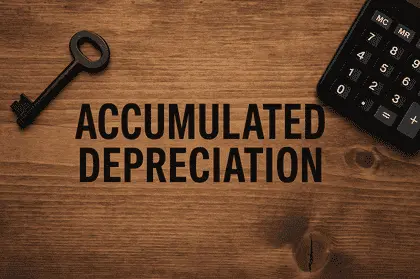Accumulated Depreciation for Florida Small Businesses
Accumulated depreciation sounds complicated, but it’s really not. If you run a small business in Florida, you probably deal with it already, even if you don’t realize it.
It’s simply the total value your business assets have lost over time, recorded in your books.
Think of your delivery van, the coffee machine in your shop, or the laptops in your office. The moment you bought them, they started losing value. This loss happens bit by bit. Over time, the total amount lost is called accumulated depreciation.
And here’s the good part, this number can help lower your taxes.

What Is Accumulated Depreciation?
In plain words, accumulated depreciation is the total amount of depreciation recorded for an asset since you first bought it.
Every month or year, you record a depreciation expense. These amounts add up. That total is your accumulated depreciation.
Example:
- Year 1: $5,000 depreciation
- Year 2: $5,000 depreciation
- Total after 2 years: $10,000 accumulated depreciation
This number grows each year until the asset is fully depreciated.
If you want to see the official IRS explanation, you can read it here.
Is Accumulated Depreciation an Asset?
No. Many people ask, is accumulated depreciation an asset? It isn’t.
It’s what accountants call a contra asset. This means it’s linked to an asset but reduces that asset’s value.
Example on your balance sheet:
- Machine: $50,000
- Less accumulated depreciation: ($15,000)
- Net book value: $35,000
That $35,000 is the accounting value of the asset. It’s not necessarily the price you’d get if you sold it today.
Is Accumulated Depreciation a Debit or Credit?
Is accumulated depreciation a debit or credit? It’s a credit.
In accounting, assets go up with debits and go down with credits. Since accumulated depreciation lowers the value of the asset, it’s recorded as a credit.
Depreciation expense, however, is a debit. They work together. When you record depreciation expense, you also credit accumulated depreciation.
Why It Matters on the Balance Sheet
Your accumulated depreciation on balance sheet is more than just a number.
It shows how much of an asset’s cost has been used up. If accumulated depreciation is close to the asset’s cost, the asset is old. That means higher repair costs or a replacement soon.
It also tells banks, investors, and even the IRS how your business manages its equipment and property.
Depreciation Formula
The most common formula for depreciation is simple:
(Cost – Salvage Value) ÷ Useful Life
Example:
Cost = $60,000
Salvage value = $5,000
Useful life = 10 years
(60,000 – 5,000) ÷ 10 = $5,500 per year
That $5,500 is recorded as depreciation expense each year until the asset’s value is fully used up.
Straight Line Depreciation Formula
This is the easiest and most common method. You record the same amount every year.
Example for a Florida roofing company:
- Equipment cost: $40,000
- Salvage value: $4,000
- Life: 8 years
(40,000 – 4,000) ÷ 8 = $4,500 per year
That $4,500 is added to your accumulated depreciation total each year.

Other Depreciation Methods
While straight line is common, there are other options:
- Declining balance: Higher depreciation in the first years, less later.
- Units of production: Based on usage, like miles driven or hours used.
- Sum-of-the-years’ digits: Another accelerated method.
Most small businesses in Florida choose straight line because it’s simple and predictable. But accelerated methods can save more on taxes in the early years.
How to Track Accumulated Depreciation
Using accounting software like QuickBooks, Xero, or Wave makes this easy. You enter the asset’s cost, useful life, and salvage value. The system calculates it for you.
If you want industry-specific help, see Roofers Accountant or Industries We Serve.
You can track depreciation manually in a spreadsheet too. Just remember to update it on time every year or month.
IRS Rules for Depreciation
The IRS sets rules for how and when you can depreciate assets. Most small businesses use MACRS, the Modified Accelerated Cost Recovery System.
MACRS often gives bigger deductions in the early years. That can help reduce taxes sooner.
For the official details, read the IRS guide here.
Taxes and Depreciation
Depreciation lowers your taxable income, which means less tax.
Example:
Profit before depreciation: $100,000
Depreciation expense: $15,000
Taxable income: $85,000
That $15,000 could mean thousands in tax savings.
Some Florida business owners even buy new equipment near year-end to get the tax deduction for that year.
You can Book Your Appointment to check if this works for you.
Mistakes to Avoid
When it comes to accumulated depreciation, there are a few common mistakes that can cost you money or create problems with your books.
1. Ignoring upgrades
If you add a new part or upgrade to an asset, its value may go up. That means you might need to adjust the depreciation amount. For example, if you replace the engine in your delivery van, that van could last longer. If you don’t update your records, your depreciation schedule will be wrong, and your books won’t show the true value.
2. Mixing personal and business assets
Never mix the two. If you buy something for your home but record it as a business asset, the IRS could see that as a red flag. Keep personal items off your business balance sheet. Only record things your business actually uses to make money.
3. Guessing the asset’s life
Don’t just pick a number for how long an asset will last. The IRS has life expectancy tables for different types of property. Using these ensures you’re following the rules and helps avoid tax issues later. Guessing can lead to wrong depreciation amounts and messy financial reports.
Florida Real-Life Example
Maria owns a landscaping business in Tampa. She buys a truck for $45,000. It will last 7 years and be worth $5,000 at the end.
(45,000 – 5,000) ÷ 7 = $5,714 depreciation each year.
After 3 years, her accumulated depreciation is $17,142. Her truck’s book value is $27,858.
Now she knows she should start saving for a replacement around year 6.
FAQ on Accumulated Depreciation
Is accumulated depreciation an asset?
No, it reduces the asset’s value.
Is it a debit or credit?
It’s a credit.
Does it affect cash flow?
No, but it lowers taxable income.
What’s the formula?
(Cost – Salvage Value) ÷ Useful Life.
Year-End Depreciation Checklist
Before the year ends, do this:
- List all assets – Include purchase price, date, and life.
- Check for upgrades – Add improvements to the asset’s value.
- Review IRS guidelines – Make sure you’re following the right rules.
- Update depreciation schedules – In your software or spreadsheet.
- Plan replacements – Before repair costs get too high.
- Talk to your accountant – Find tax savings opportunities.

Depreciation Planning Tips for Florida Businesses
Florida businesses face unique challenges, heat, humidity, and hurricanes can shorten the life of equipment. This can affect your depreciation schedules.
Tips:
- For vehicles, factor in salt air if near the coast, it can speed up wear.
- For outdoor equipment, store it indoors when possible to extend life.
- Consider accelerated depreciation if weather shortens asset lifespan.
- Track maintenance costs, rising repairs may mean replacement is smarter.
Why It Matters
Accumulated depreciation isn’t just an accounting term. It’s a tool for planning, saving on taxes, and making smart business moves.
By tracking it, you can:
- See when to replace assets.
- Lower your tax bill.
- Keep your financial statements accurate.
If you manage it well, you’ll avoid nasty surprises, keep costs under control, and make better investment choices.

